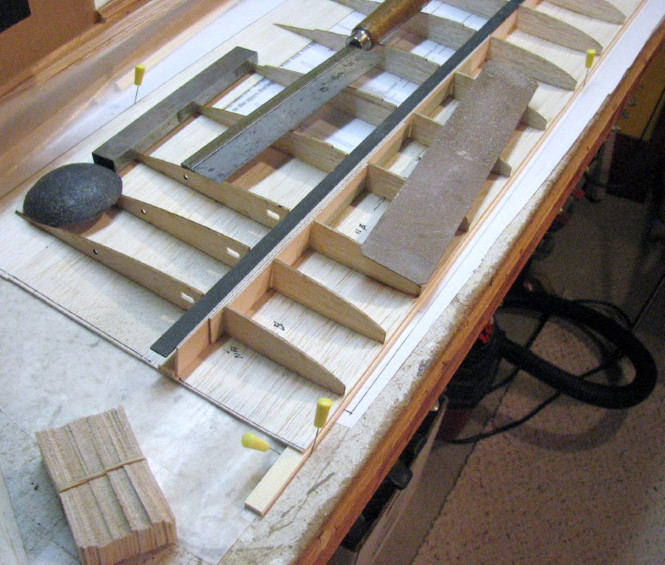
Ray's Wing Spar Horizontal Grain Plywood Shear Brace Installation.

I use a 1-1/4 inch wide Zona Saw to cut the ribs away from the
spar sides and vertical grain shear web blocks. A smaller ¾ inch wide Zona
does not have enough depth to cut the ribs.
The Perma Grit sander easily finishes the rib cut to a 1/16th wide slot.
The sander measures approx. 1/32 x 1-1/2 x 9 inches. It has a fine and rough grit.
Hold the rib during cutting and sanding or you will break it off at the sheeting.
The Slow Cure Epoxy is mixed and applied with the home made wire applicator and cleaned up around the joints with the wire applicator and Paper Towel.
Link to Perma Grit Sander located on the Sky Bench LINKS page.

It's a great hobby !

Wing:
Start wing construction by pining down the
bottom trailing edge. Use a rib to locate
front bottom sheeting and the spar location.
Brass wing joiner tube must protrude through the 1/16" plywood root caps. File tube flush after 30 minute epoxy sets.
Fuse:
Brass joiner tube in fuse must protrude through
1/16" root caps placed on outside of fuse sides.
File tube flush after 30 minute epoxy sets.
Wire pushrods cross at rear of fuse to eliminate binding.
Clean residue from wire before installing.
Cut tubing provided into short lengths, install where pushrods cross
and touch each other and on sides of fuse between fuse formers to stop
wire pushrods from bowing under load.
Use small amount of Silicone glue to adhere tubes to fuse sides.

ACCURACY OF THE RIB PROFILE IS VERY IMPORTANT TO THE WINGS PERFORMANCE. THIS IS HOW I INSURE AN ACCURATE RIB PROFILE BETWEEN THE SPAR AND THE LEADING EDGE.
BEFORE CUTTING THE RIBS AWAY FROM THE SPAR TO ATTACH THE PLYWOOD W-11 PARTS, I USE CA GLUE TO BOND THE BOTTOM OF THE RIBS TO THE BOTTOM SHEETING.
START THE GLUING PROCESS BY GLUING A RIB IN THE MIDDLE OF THE WING PANEL AND ALTERNATE GLUING THE RIBS TOWARDS EACH END OF THE PANEL.
I USE A SMALL PIECE OF 1/16" BALSA SCARP WHILE GLUING THE RIBS TO THE BOTTOM SHEETING AS A MOVING WEDGE UNDER THE BOTTOM SHEETING WHERE THE BOTTOM PROFILE OF THE RIBS START THEIR UPWARD SWEEP. THIS INSURES THE BOTTOM OF THE RIBS ARE FLUSH TO THE TOP OF THE BOTTOM SHEETING.
PIC: SEE THE STICK PROTRUDING FROM UNDER THE FRONT EDGE OF BOTTOM SHEETING. IT IS PINNED TO THE BUILDING BOARD AFTER THE RIBS ARE GLUED TO THE BOTTOM SHEETING AND BEFORE CUTTING THE RIBS. THE WEIGHTS ON TOP OF THE WING ARE USED TO INSURE THE WING IS FLAT ON THE BUILDING BOARD.

The ribs are pictured cut and ready for the Plywood brace to be installed on the front side of the spars. A shorter plywood brace will be installed to rib #7 on the rear of the spars and shorter plywood brace doublers will be installed on both sides of the spar from rib #2 to Rib #6, all with slow cure Epoxy.
Note Rib # 1 ( root rib ) has not been installed. Rib #1 is installed during the process of installing the wing rod Brass Tubes to insure the correct rib #1 angle to be flush with the fuse sides. See below for Rib # 1 info.

The front plywood shear web is shown trial fitted before gluing.
Use a stick the length of the inner panel placed under the front edge of the ribs, below the bottom wing sheeting, to maintain the wings profile. The front wing ribs that have been cut will droop without the bottom stick. I pin the stick to the building board in several places to insure accuracy of rib profile.
Make sure the Plywood shear is level with the spar top, you don't want to be sanding the Plywood shear top to be flush with the spar after it has been glued in because you will mess up the top of the wing ribs. Trail fitting is a good habit.
Note, the wing is securely pinned down to the building board and several weights are placed on the ribs behind the spar to to keep the wing flat on the building board
A twisted wing is a Sailplane's Performance worst enemy. A sailplane that requires a touch of rudder setting usually means the wings are twisted, causing it to turn one direction at cruise speed and another at faster or slower speeds. Sky Bench

The Epoxy is curing, the clamps have squeezed out the excess Epoxy and I have used the paper towel with the help of my applicator wire to clean up the Epoxy.
Epoxy is heavy, I do my best to remove any excess to save weight.


Use
a file to clean and roughen brass tubes for Epoxy to adhere to, plug
tube ends with balsa before installing tubes in wing. I use punch
system on 1/16 balsa and Ca.
Set wing up on building surface for proper amount of dihedral.
Brass wing rod tubes with rod inserted are tacked in with 5 Minute Epoxy.
Rod and tubes are level, use block system under rod for accuracy.
Tubes are held against the Plywood shear strips for easy alignment accuracy.
Ribs #1 will be installed and cavity around tubes filled with a mixture of slow cure epoxy and mirco balloons mixed to the consistency of putty. Sky Bench

And you thought there was no value to RC Sailplane Trophies ...
The value is in the trophy base. This one dates back to the good ol'e days of 1976.
The base makes a perfect vertical guide for Rib # 1.
Since the rod is level, the ribs will mount flush to the fuse sides.
Next is filling the cavities around the brass tubes and adding the plywood shears to the back side of the spars.
The 1/16” plywood root caps will be installed after the wing sheeting is completed and while mounted to the fuse sides to insure a flush fit to the fuse.
Note the 1/16th balsa used to plug the ends of the brass tubes.

Trial fit before installing with slow cure epoxy ! Always !!!

First
I applied epoxy finely to the face of the plywood shear part. Next I
applied epoxy to the edges of both spars and vertical shear blocks.
Mixed a new batch of epoxy and added Micro balloons, then filled
brass tube area. Epoxy/Micro balloon mix has to sink into cavity and
surround brass tube and fill cavity completely. I help the
sinking/filling process by working a pin into the mix allowing the
trapped air below the epoxy to escape. I slightly over fill the
brass tube area, when the clamps are applied, the pressure will press
the mix and the excess will squeeze out.

Next
step is installing the two alignment wire tubes.

Make
sure the rod and wire are parallel and level with each other. Sky
Bench
After installing the wing rod and alignment tubes the inner panels ( before adding the tip panels ) are fitted to the fuse to install the corresponding tubes inside the fuse.
Two blocks are placed on each side of the fuse for the wing roots to rest on and provide the wing halves to be set up accurately, meaning the wings are not twisted.
Twisted wings require different rudder settings at different speeds because they make the sailplane turn in one direction or the other. The rudder offset causes increased drag. They also are causing excessive drag because they are not flying at the same angle of incidence. Maximum flight performance can be acquired only with accurate flying surface settings and the proper balance location.

This
product makes epoxy weight less. Experiment with varying amounts
until you learn the proper thickness for different applications.
Install
brass wing rod tube and alignment tube in fuse before attaching wing
tip panels. I have been using these two block for years to align the
wings to a fuse to insure the inner wing panels will not have a
twist. Twist meaning, each wing with a slightly different incidence
angle.
A
sailplane will turn to the high end of the stab, because the stab
wants to fly level. So make
sure the stab is horizontal to the wing, easy to check by sighting
from the front of the fuse while plane is on the blocks.
The Big
Bird XL wing pictured in all the preceding pages is not the wing
pictured above. This is a photo of my Ed Slobod's design Pierce 970
that features a flying stab and a thin flat bottom airfoil.
The white
aluminum tube with a screw cap is the ballast tube.
Top hatch
will be glued in permanently. All Rights
Reserved © 2012 Sky
Bench
Ray Hayes

https://www.skybench.com
| Sky Bench
Aerotech PO Box 13 Brownsburg, IN 46112 e mail skybenchone@gmail.com 
|